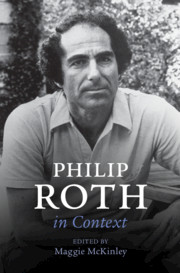Book contents
- Philip Roth in Context
- Philip Roth in Context
- Copyright page
- Contents
- Notes on Contributors
- A Note on References and Abbreviations
- Introduction
- Part I Life and Literary Contexts
- Part II Critical Contexts
- Chapter 6 The Early Years
- Chapter 7 Portnoy and Its Aftermath
- Chapter 8 The Zuckerman Books
- Chapter 9 The Kepesh Books
- Chapter 10 The “Philip Roth” Books
- Chapter 11 The Late Novellas
- Part III Geographical Contexts
- Part IV Theoretical Contexts
- Part V Jewish American Identity
- Part VI Gender and Sexuality
- Part VII Political Contexts
- Part VIII Roth’s Legacy
- Primary Bibliography
- Selected Secondary Bibliography
- Index
Chapter 8 - The Zuckerman Books
from Part II - Critical Contexts
Published online by Cambridge University Press: 15 July 2021
- Philip Roth in Context
- Philip Roth in Context
- Copyright page
- Contents
- Notes on Contributors
- A Note on References and Abbreviations
- Introduction
- Part I Life and Literary Contexts
- Part II Critical Contexts
- Chapter 6 The Early Years
- Chapter 7 Portnoy and Its Aftermath
- Chapter 8 The Zuckerman Books
- Chapter 9 The Kepesh Books
- Chapter 10 The “Philip Roth” Books
- Chapter 11 The Late Novellas
- Part III Geographical Contexts
- Part IV Theoretical Contexts
- Part V Jewish American Identity
- Part VI Gender and Sexuality
- Part VII Political Contexts
- Part VIII Roth’s Legacy
- Primary Bibliography
- Selected Secondary Bibliography
- Index
Summary
Nathan Zuckerman is one of Roth’s most central characters, and any thorough study of Roth and his work requires an exploration of Zuckerman’s role in Roth’s development as a writer. In many ways, Roth’s career, his concerns, and his confrontation with illness and age, are reflected and refracted through Zuckerman, This chapter addresses the interpretation of Zuckerman as one of Roth’s “alter-egos”, from the time he first appears in 1974 in My Life as a Man, to his role in novels now collected as “Zuckerman Bound” [The Ghost Writer (1979), Zuckerman Unbound (1981), The Anatomy Lesson (1983), and The Prague Orgy (1985)] to The Counterlife (1986), and then the “American Trilogy”—American Pastoral (1997), I Married A Communist (1998), and The Human Stain (2000)—before bidding farewell in 2007’s Exit Ghost.
- Type
- Chapter
- Information
- Philip Roth in Context , pp. 81 - 90Publisher: Cambridge University PressPrint publication year: 2021

